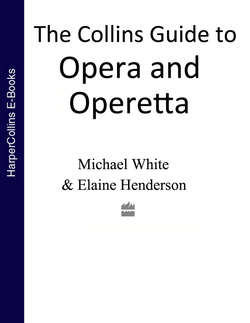Читать книгу The Collins Guide To Opera And Operetta - Michael White - Страница 52
ОглавлениеMédée
(Medea)
FORM: Opera in three acts; in French
COMPOSER: Luigi Cherubini (1760–1842)
LIERETTO: F-B. Hoffman
FIRST PERFORMANCE: Paris, 13 March 1797
Principal Characters
Medea, former wife of Jason Soprano
Jason, leader of the Argonauts Tenor
Creon, King of Corinth Bass
Dirce, Creon’s daughter Soprano
Neris, Medea’s servant Mezzo-soprano
Synopsis of the Plot
Setting: Creon’s palace and Corinth; mythological Greece
ACT I Jason has abandoned the murderous Medea and, with their two sons, has made his home in Corinth. He now wishes to marry Creon’s daughter, Dirce, but she has considerable doubts about the wisdom of the union, despite reassurances from her father that Medea will not harm them. A few moments later a stranger is admitted, to be revealed as Medea herself. Creon orders her to leave or suffer imprisonment. Left alone with Jason, Medea tries every means in her power to persuade him to come back to her, but he stands firm.
ACT II By the next morning the people, hearing of Medea’s presence, are demanding her blood. Creon warns her to escape while she can, but she begs him to let her stay just one more day so that she can see her children, and he agrees. Left alone, Medea plans her revenge as the sound of wedding music is heard in the distance.
ACT III Medea calls on the gods of the underworld to help her as a storm rages round the temple and the palace. Medea’s children are brought to her by Neris and, firmly repressing any faint stirrings of maternal feeling, she drags them into the temple and stabs them. From the palace come the horrifying cries of the dying Dirce, poisoned by the wedding presents Medea had contrived to give her. Jason and the crowd come after Medea, but it is too late: before he can reach the temple she appears in the doorway, surrounded by the Furies, and curses Jason, holding aloft the knife with which she has killed the children. Terrorstricken, the people scatter as the temple bursts into flames.
Music and Background
Médée is a work of highly charged musical drama, focused on two characters, Jason and Medea, and two subjects, revenge and death. The grand, Classical story may look back to the old, aristocratic manner of opera before the Revolution, but the fierceness of the story-telling puts it in a different league, and Médée is in fact the only Revolutionary-period opera to have found a lasting place in the repertory. The title role is towering, an exhausting challenge for the singer. And although the score was written with spoken dialogue in the manner known as opéra comique, there are decidedly no laughs.
Highlights
The Jason/Medea duet that closes Act I is classical drama at its best, and Neris’ Act II aria ‘Ah, nos peines’ has touching beauty; but the musical dynamism in this opera comes in Act III, whose furious temper is set by the opening orchestral storm and escalates throughout into the final conflagration.
Did You Know?
The death of the first soprano to tackle Medea was widely thought to be a consequence of the strain of singing the part.
Recommended Recording
Sylvia Sass, Veriano Luchetti, Budapest Symphony Orchestra/Lamberto Gardelli. Hungaraton HCD 11904/5. A better all-round performance than the legendary but flawed 1950s recording with Maria Callas.
